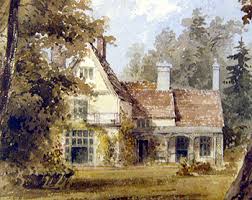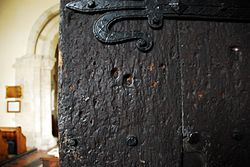 |
| Alfriston Vicarage - Tudor |
I have recently been researching background information for the character of a 17th century parson, so I thought I'd share a few snippets of information about their households, or parsonages. First what is a parson? A parson is 'the priest of an independent parish church not under the control of a larger ecclesiastical or monastic organization.'(Wikipedia) Often the term is interchangeable with 'rector' or with 'vicar', but historically these terms are dependent on the status of the person with regard to their tithes. More information about this complex terminology can be found
here
The first parsonages were very simple affairs constructed from wattle and daub, roofed with thatch or shingles.
 |
| Solar, Churche's Mansion, Nantwich Cheshire |
As time went on more elaborate dwellings began to be built so that by the Middle Ages some parsonages were equipped wih a solar (warm sunny gallery on the first floor) or more chambers to receive guests, such as the one in West Dean Sussex with its tracery windows and newel staircase.
 |
| West Dean Rectory |
Most 17th century parsonages were housed within church grounds or close by so that parishioners could know where to find the incumbent.At this time the parson was allowed to have 'husbote' or free wood for his fires and for repairs to his outbuildings. Most parsonages also had stabling for horses as it was a prerequisite that he should offer hospitality to those who demanded it.
 |
Flitton Vicarage in 1827,built in 1606 painted by Rev. Henry Wellesley |
Because of the duty of hospitality the household would usually consist of a number of servants as well as the vicar himself. Matthew Knyghtley's rectory in Leicestershire was run by 'a day-woman, two servants and a cook'. Although the rector or parson of the 16th and 17th century was more often celibate, there were a number of married clergy, known as
uxorati, as well as untold numbers of 'co-habitations' with servants, 'nieces' and 'spiritual daughters'.
This behaviour was seldom censured by the church, but met with wide disapproval amongst parishioners. In June 1610 a Mr and Mrs Holland declared that 'The World was never merrie since priests were married'.
The practice of marriage was popularised in the West by the followers of Martin Luther who himself, a former priest and monk, married Katharina Von Bora, a former nun, in 1525. In the Church of England, however, the Catholic tradition of clerical celibacy continued after the Reformation, though in 1547, in the reign of Edward VI Anglican priests were allowed to marry for the first time.
Some parsons had such large families that they found it hard to manage financially. The Vicar of Hungerton in 1614 said, 'my livinge is very small...if I had not lately received a gratuity I had not been able to maintayne myselfe and eight children'.

In most rectories furniture was simple - trestle tables, benches and stools, with pewter dishes, horn drinking cups and iron cooking vessels. After the Reformation a parson or rector was supposed to avoid ostentation in his personal belongings but it was considered perfectly acceptable for him to brew his own beer and many parsonages also had a brewhouse attached.
In towns where the population was bigger, the rectory could be a grander affair. The parson's study had become a necessity since the Elizabethan drive to raise the standard of education of the clergy, so many 17th century clergy owned considerable libraries. When Matthew Knyghtley died, his books were valued at twenty pounds, whereas his three silver spoons were worth only 12 shillings. As books were so valuable the study often contained a bed, for the books were too rare and costly to be left unguarded, and would frequently be studied deep into the night.
During the Civil Wars many parsonages and rectories were plundered - not always by the Roundheads but by both sides. Usually the troops were after bedding - plentiful in a vicarage where hospitality was the norm. John Dod, Vicar of Fawsley was looted three times by the Cavaliers. On the second occasion he was ill in bed and they stole the pillows from under him, on the third occasion he outwitted them by hiding some goods including his best sheets, under the cushion he was sitting on.
And at Kilworth in Leicestershire the disposessed Royalist rector Samuel Cotton, assisted by some Cavaliers, ousted the Presbyterian successsor and his wife in the middle of the night and took over their former home, placing guards at the doors to prevent them re-entering.The walls of the rectories would have some exciting stories to tell if we could only unlock them!
 |
Church of St Lawrence, Alton, Hampshire showing shot holes from
the English Civil War |
Thank you for reading, my website is at
www.deborahswift.blogspot.com
and you can find out more about my novels here:
The Lady's Slipper The Gilded Lily A Divided Inheritance
Further Info:
The Country Priest in English History by A.Tindal Hart
Birth Marriage and Death in Tudor and Stuart England by David Cressy



